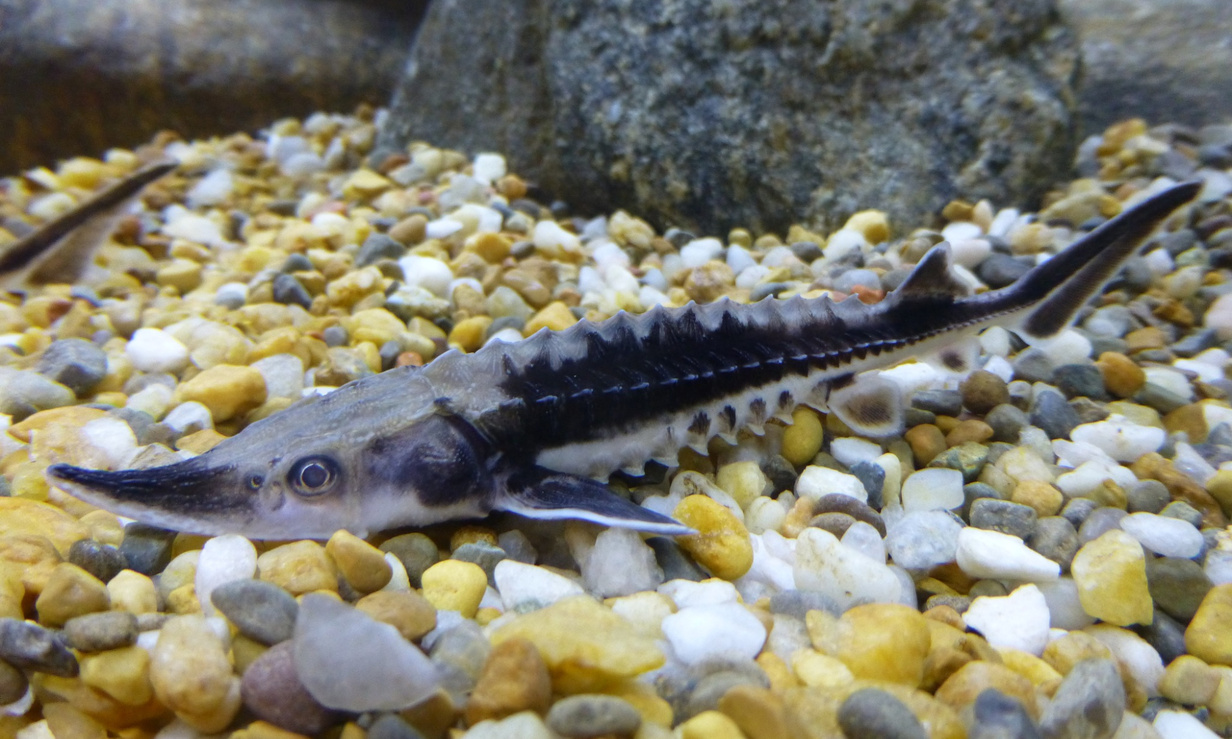
Why The Grand Traverse Band Is Working To Bring Lake Sturgeon Back To The Boardman-Ottaway River
By Craig Manning | Sept. 7, 2024
Once upon a time, lake sturgeon were among the largest, most abundant fish in the Great Lakes region – so prevalent, some say, you could “walk across a river on their backs.” Centuries of overharvesting, damaging industrial activity, and disruption to rivers and streams largely wiped out the population – to the point where modern experts estimate lake sturgeon to be roughly 1 percent as prevalent as they once were.
For the past two decades, Native American tribes in Michigan have been leading a charge to bring sturgeon back to prominence. This weekend, that fight comes to northern Michigan, with the Grand Traverse Band of Ottawa and Chippewa Indians (GTB) kicking off an ambitious project to restore sturgeon to their once-native waters in the Boardman-Ottaway River.
Lake sturgeon’s days of abundance in the Great Lakes occurred before European settlers arrived. Most experts point to logging activities – prevalent in Michigan, including in the Traverse City area – as the original sin in destroying the population, as the practice of floating logs downriver crowded the fish out of their preferred spawning habitats. Later, it was the popularity of hydroelectric dams that posed challenges, as those barriers cut sturgeon off from preferred spawning sites.
Years of overharvesting didn’t help, nor did the sturgeon’s long march to maturity. Lake sturgeon can live for a hundred years or longer, but typically take 15-20 years to reach sexual maturity and are vulnerable in their infancy to a range of predators. In other words, once the sturgeon population in the Great Lakes had been wiped out, it didn’t bounce back.
In 2004, the Little River Band of Ottawa Indians Natural Resources Department launched the state’s first-ever streamside rearing facility for lake sturgeon in hopes of providing a space where juvenile sturgeon could grow beyond their most vulnerable phase. The Huron Daily Tribune, which credits the Little River project with helping sturgeon “stave off extinction” in Michigan, notes that 0.01 percent of sturgeon eggs actually make it to adulthood. By providing a safe space for the fish to grow and thrive – and then releasing them once they were big enough to fend for themselves – the Little River Band was able to push that survival rate to more like 80 percent. The program has released approximately 2,400 sturgeon into the Manistee River.
According to players within the GTB Natural Resources Department, the local tribe has wanted to do something similar on the Boardman-Ottaway for years but has been stymied by the river’s dams. In fact, according to Brett Fessel – the restoration section leader for that tribal department – it was back in 2004 when GTB first connected with the state DNR and the City of Traverse City on the topic of river restoration. Those talks led to the removal of the upper three dams on the river but left the last one in place.
“During the time we were planning for all these removals, we were discussing what to do with the last dam at Union Street, which is essentially a doorway to the Great Lakes, and the only barrier that prevented the full reconnection of the watershed to the Great Lakes,” Fessel tells The Ticker. “We decided we should modify that dam [rather than remove it] because of the threat of sea lamprey and other species getting into the watershed.”
The city’s long-delayed FishPass project will finally make that modification a reality. The next step for GTB is restoring the river as a habitat and passageway for native fish species. Per Fessel, lake sturgeon are the “focal species” for those efforts, due to how rarely they’re spotted in the Boardman-Ottaway.
Dan Mays, the lead inland biologist for the tribe’s natural resources department, is one of the few people to have caught a sturgeon on the Boardman. A few years ago, he found a mature female sturgeon “mulling about” below the Union Street Dam. GTB tagged the fish and released it back into the wild, and has been tracking it ever since.
“It’s a five-foot-long female, and it’s come back several years,” Mays says. “We’ve had it ping on our acoustic telemetry arrays – not necessarily coming up the river, but in the region. This past year, it came right into the estuary, checking things out. Probably, it doesn’t see any other sturgeon and then heads back out.”
This particular sturgeon has also been pinged as far away as Wisconsin. Fessel sees its repeated return to the Boardman as proof that it has a connection to northern Michigan waters. When they’re born, sturgeon imprint upon the chemical cues of their native water, and then use those cues to “smell” their way back home. The process is what allows sturgeon to return to the same rivers to spawn – and why cutting them off from prime streams like the Boardman is a problem.
Today, GTB will take a step toward restoration by releasing hundreds of juvenile sturgeon into the Boardman’s waters at Hannah Park. Sean Musk, the tribe’s fish and wildlife biologist, has been raising the fish for months in tanks filled with water from the Boardman, feeding and nourishing them from their larval stage to the point where they are now big enough to be tagged and released. The tribe will do similar sturgeon releases each fall going forward. The goal is to establish a self-sustaining population of 750 spawning adult sturgeon in the Boardman-Ottaway by 2044 – a number Musk says would allow the tribe to “step back” and let nature take its course.
Locals shouldn’t expect to see much sturgeon activity on the Boardman-Ottaway anytime soon, though. These juvenile fish won’t be looking for a place to spawn for more than a decade, and FishPass won’t even be up and running until 2027. In the long run, though, the project could have reverberations that reach far beyond local waters, and far beyond a single species of fish.
“We’ve had a lot of interest from all around the globe for FishPass, in terms of the potential implications of our research for other sites,” says Dan Zielinski, principal engineer for the Great Lakes Fishery Commission and a key architect of the first-of-its-kind FishPass system. Once complete, FishPass will harness dozens of technologies to monitor the species that approach the barrier at Union Street and decide which ones to let through. How well all that technology works, including for species like sturgeon, will determine just how far the ideas behind FishPass go.
“There are more dams being built globally than are being removed,” Zielinski notes. “And they all need fish passage solutions.”
Pictured: A juvenile sturgeon, courtesy of the Great Lakes Fishery Commission.
Comment






